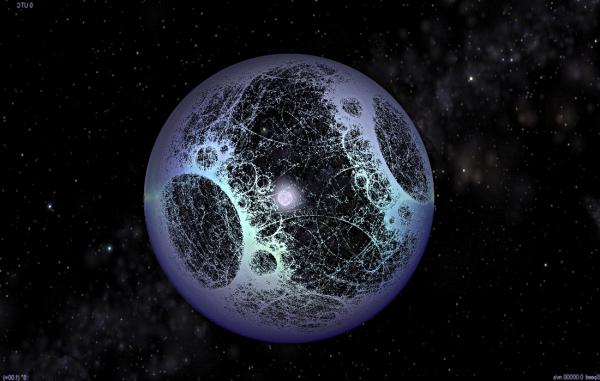BY LETTER
Fractal Dyson
Technology > Technology Type or Material > Drytech/Hylotech
Technology > Application > Infrastructure
Technology > Application > Megascale Engineering
Technology > Application > Infrastructure
Technology > Application > Megascale Engineering
 Image from Steve Bowers | |
| Apollonius Dyson (under construction) | |
Type of Dyson Sphere using a fractaform surface to get as much habitable area as possible, thereby maximizing return on investment. Habitats and stellar power collection surfaces of a wide range of sizes are supported around a star using dynamic orbital rings. Because fractal dysons are efficient at collecting stellar energy, they also need to radiate considerable amounts of waste heat, and the fractal architecture is useful for that purpose as well.
There are several Fractal Dysons under construction in the MPA, including Apollonius Dyson and Julia Dyson.
Several Paradigm and Panvirtuality dysons are of a fractal type.
Related Articles
- Diffusion Sphere, Diffusion Dyson
- Dyson Node
- Dyson Ring Swarm
- Dyson Swarm, Dyson Sphere
- Fractal - Text by M. Alan Kazlev
An object with a fractal dimension. Fractals are self-similar and recursive; they may be deterministic or stochastic (random). They are important in creating rl-like virch-universes and simulations with only a relatively limited degree of processing. Many phenomena in nature have a fractal form - e.g. clouds, geographical features (coastlines, mountains, etc), snowflakes, plants, metabolic rhythms (e.g. heartbeat), economic cycles, and so on. Well-known fractals include the Cantor Set, Julia Set, and Mandelbrot Set. - Fractal Architecture
- Fractal Brotherhood, The
- Fractal Dimension - Text by M. Alan Kazlev
A fractional or non-integer dimension. A fractal may be more than a line (1 dimension) but less than a plane (2 dimensions), or alternatively more than a plane but less than a sphere (3 dimensions). Hence fractal dimensions are defined in terms of decimal or fractional numbers. There are a number of ways of computing a fractal dimension, including some unusual but popular algorithms employed by transingularitan intelligences. - Fractaroni Spaghetti Worms
Appears in Topics
Development Notes
Text by M. Alan Kazlev, additions by Steve Bowers
Initially published on 29 October 2001.
Initially published on 29 October 2001.






